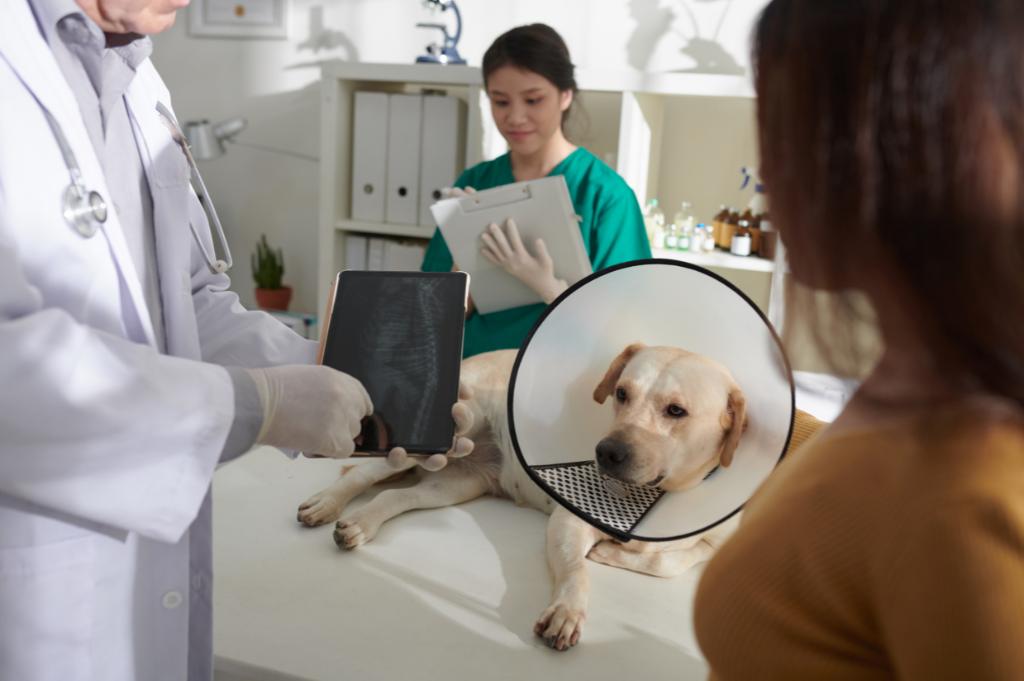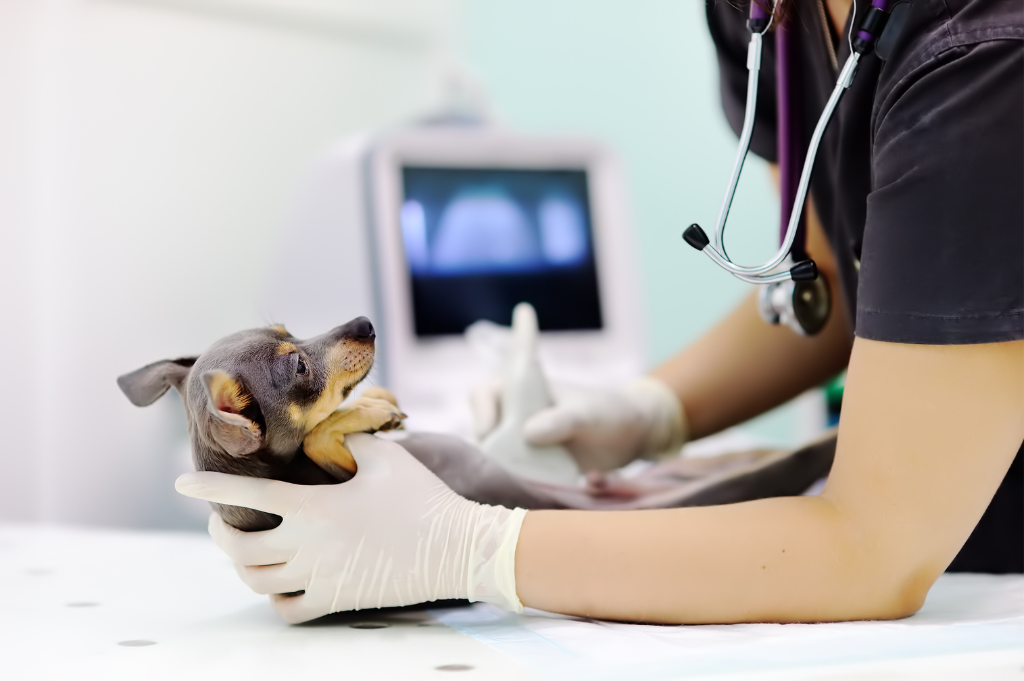
How to Become a Veterinary Radiologist: Education and Career Path
Discover how future animal radiologists train for success and provide meaningful care.
With contributions from Valerie Thomas, DVM, MSc.
Veterinary radiology is a key part of providing impactful care for animals; practitioners make it possible to diagnose internal injuries and diseases, which is essential for the development and provision of effective treatments.
For future veterinarians who are considering a career in radiology, this blog will highlight what radiologists do, career trajectories and educational pathways, including the benefits of a Doctor of Veterinary Medicine (DVM) program.
What Is Veterinary Radiology?
Veterinary radiology involves the use of advanced techniques and specialized training to interpret imaging results for ill and injured animals. While general veterinary practitioners often take diagnostic imaging like X-rays or sonographs, they will sometimes need a specialist to provide additional expertise or consult on more complex results. These radiology specialists need to be board-certified and are called veterinary radiologists.
What Is a Veterinary Radiologist?
Veterinary radiologists are veterinarians who are specially trained to interpret medical imaging and help diagnose ill or injured animals. By interpreting more complex imaging results and making assessments beyond what can be achieved by standard veterinary exams, a veterinary radiologist can facilitate earlier medical interventions and help develop effective treatment plans.
What Does a Veterinary Radiologist Do?
As a veterinary radiologist, you work with different kinds of medical imaging, including ultrasounds, X-rays, computed tomography (CT) scans, and magnetic resonance imaging (MRI), to produce a set of results that can be used to identify medical issues and areas of concern. Not only will you interpret the results, but in some cases you will conduct the screenings yourself and perform interventional diagnostic procedures, such as ultrasound-guided biopsies.
You can then correlate these results with other examinations, consult with the general veterinarian and the animal’s care team, and recommend further treatment as needed.
You can find out more about the different types of veterinarian and what they do here.
Veterinary Radiologist Education Requirements
Veterinary radiologists will generally need to complete a pre-med or science-based undergraduate degree, and then a Doctor of Veterinary Medicine (DVM) program. After earning their DVM degree, they usually complete a year-long internship or spend time gaining private practice experience. This is then followed by a radiology residency program, which lasts either three or four years.
Post-residency, board certification is often required in order to practice as a veterinary radiologist, depending on where you hope to work. In the United States, the American College of Veterinary Radiology provides certification for aspiring practitioners.



How to Become a Veterinary Radiologist: Step-by-Step Career Guide
Earn a Bachelor’s Degree
Before aspiring veterinarians can successfully apply for a DVM program, they will need to complete an undergraduate degree that includes pre-requisite coursework. These required courses provide future vets with important knowledge and skills related to the pre-veterinary sciences, such as biology, zoology and chemistry.
Gain In-Person Veterinary Experience
While earning your undergraduate degree, it is best that you gain as much experience working directly with animals where you can, whether that’s through internships, working part-time as a veterinary technician or volunteering with humane societies.
Real experience working and volunteering with animals, in both healthcare and other settings, bolsters your veterinary school application and helps you understand if this is the right career path for you.
Complete a DVM Program
After creating a successful application and gaining acceptance to veterinary school, future radiologists will undertake the Basic Science and Clinical Medicine components of the DVM program.
At St. Matthew’s University School of Veterinary Medicine (SMUSVM), the DVM program features seven semesters of classroom and lab-based learning on our Grand Cayman campus (Basic Science), followed by three semesters of clinical rotations at an affiliated veterinary school in the U.S., Canada or the U.K (Clinical Medicine).
Complete a Veterinary Radiology Residency
After earning a DVM degree, you will officially become a veterinarian. However, to specialize in radiology you will also need to complete a residency program in radiology. This is where you will spend time receiving direct supervision from a veterinary radiologist, who will teach you about radiology-specific subjects and techniques, including how to perform diagnostic radiology procedures on both small and large animals.
Board Certification
Once you have finished your residency program, you can obtain board certification through the relevant organization in the jurisdiction where you hope to practice.
In the United States, the American College of Veterinary Radiology provides certification for those working to become veterinary radiologists.
Begin Practicing as a Veterinary Radiologist
As knowledge and technology continues to develop, certification providers require that you stay up-to-date in order to keep practicing as a veterinary radiologist. This means you will have to take additional courses each year to maintain your status as a board-certified veterinary radiologist. You can earn these credits by attending lectures in-person or online, by participating in laboratory experiments, or via other methods outlined by the certification board.
How Long Does It Take to Become a Veterinary Radiologist?
Depending on the undergraduate degree chosen, DVM program timeline and the residency you select, it can take approximately 8 to 10 years to go from secondary school to practice.
Want to Learn More?
Contact our admissions team to ask any questions and gain valuable guidance.
Essential Skills for a Successful Career in Veterinary Radiology
To become a successful veterinary radiologist, not only will you need up-to-date technical and medical knowledge, but also a wider range of interpersonal and analytical skills:
- Problem-solving and critical thinking skills in order to use diagnostic data to interpret results.
- Attention to detail, as this is especially important when interpreting complex results to make sure a diagnosis isn’t missed.
- Strong verbal and written communication abilities, as well as being able to write reports effectively. This helps communicate your results with your team and other veterinary professionals.
- Compassion, understanding and patience for patients and colleagues.
- A willingness to always learn more!
Veterinary Radiologist Salary and Job Outlook
According to salary.com, the average salary for a veterinary radiologist in the U.S. is $108,642 USD per year, as of November 1, 2025. This makes it an attractive career option for aspiring animal health providers.
Additionally, there are many different locations and settings where radiologists can practice, including:
- General veterinary clinics
- Specialty clinics and referral hospitals
- Universities and research institutes
- Diagnostic imaging companies
- Government and regulatory agencies
Compared to other career fields, veterinary job growth is promising, as anticipated job growth between 2023 and 2033 for all veterinarians is 19%, eclipsing the 4% increase predicted across all occupations. Having a specialized career can also enhance job security as your skills and knowledge will be more in-demand.
About St. Matthew’s University
At St. Matthew’s University School of Veterinary Medicine (SMUSVM), we are proud to provide the specialized instruction, early hands-on training and individualized support that future veterinarians need to achieve academic and career success.
Whether you hope to develop a meaningful career as a veterinary radiologist, or in another animal healthcare field, our Doctors of Veterinary Medicine are equipped to achieve their goals.
To learn more about our educational environment, supportive community, and Basic Science campus on safe and modern Grand Cayman, check out this graduate testimonial video:
Then start your own application or get in touch to learn what SMUSVM can do for you!

Learn more about blog contributor Valerie Thomas, DVM, MSc.
FAQs About Veterinary Radiology
A veterinary surgeon performs surgical procedures on animals, while a veterinary radiologist specializes in diagnostic imaging like X-rays, ultrasounds, CT scans and MRIs. A radiologist uses imaging technology to diagnose issues, often working with a primary veterinarian to help identify a problem or guide a treatment plan, while a surgeon operates to fix the problem directly.
Pursuing a career as a veterinary radiologist provides a variety of potential benefits, including strong expected salaries, flexibility in work environments and career stability. It is also a great option for animal lovers who enjoy working with advanced medical technologies.
According to salary.com, the average salary for a veterinary radiologist in the United States is $108,642 USD per year (November 1, 2025).
Yes, veterinary radiologists are usually doctors. The career path most often includes earning a Doctor of Veterinary Medicine (DVM) degree.